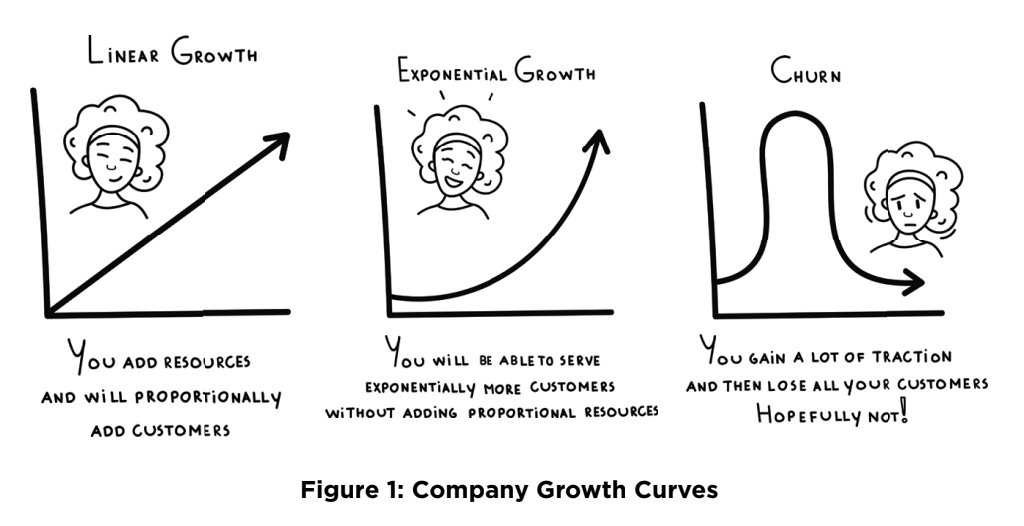Below is an excerpt from Anne Cocquyt’s new book, Dare To Launch: Mini MBA for First-Time Entrepreneurs. Cocquyt is the Founder and CEO of the GUILD Academy, a global program for first-time entrepreneurs.
In this bestselling book, she writes about her own startup experiences and translates inspiring stories from female founders into a practical guide for entrepreneurs on their path to success.
The span of starting a business or calling yourself an entrepreneur ranges from handing out a freshly printed business card all the way to being the CEO of a publicly traded company.
When you close your eyes, what comes to mind when you hear the word entrepreneur? What pictures do you see?
- Is it a corner office overlooking the ocean?
- Could it be a grungy house with lots of roommates, Post-Its all over the wall, and empty ramen noodle containers?
- Are you on a TED stage?
- Do you see yourself in an AirBnB in Iceland, embracing a hot cup of tea while you work on your laptop to book your next business trip?
- Do you envision a picture of you on the front of Forbes titled “Entrepreneur of the Year,” ringing the opening bell on Wall Street?
- Are you producing a video for your sustainable energy product?
The beauty of entrepreneurship is that it’s not one narrowly defined trait.
We define an entrepreneur as a person who organizes and operates a business or businesses, taking on greater than normal financial risks in order to do so.
I would add that a good entrepreneur organizes and operates businesses well and takes calculated risks by learning from others how to de-risk their investment and actions.
I’m not here to tell you which entrepreneur is the real deal and to what you should aspire. I will tell you that right now is the best time to take a minute and ask yourself what drives you to entrepreneurship and why you want to start your own business. Be brutally honest with yourself. I guarantee it will save you lots of time and hardship in the years to come.
- Do you want to escape the monotony of your 9-5 job?
- Do you feel like you’re born to do something else?
- Do you want to work on your legacy?
- Are you really worried about a problem you, your friends, family, or the world needs to solve—even though you’re an outsider with little experience in that field?
- Do you get an electric tingle when you think about starting your own thing, being your own boss, and creating something out of nothing?
- Do you need this business to become independent or to finance the lifestyle of your dreams?
- Did you discover a business opportunity too good not to take?
- Are you a natural creator who finally wants to turn your side hustle into a company that sustains you?
- Do you want to be recognized for your genius in different ways than what your current employer does now?
Starting a business is a trade-off—no matter what you did before: a 9-5 job, staying at home as a full-time parent, studying, or not having worked at all. You’ll free yourself of something, gain something new, and give up something else in return.
Before we dive into the different kinds of businesses you may start and before understanding the philosophies behind each, take the time to listen to your inner core and be very honest as to WHY you want to become an entrepreneur and WHY you want to start a business. What does your future look like when you will have achieved success in every step this book outlines?
SCALABLE VS. NON–SCALABLE BUSINESSES
There are many ways to slice a cake. To help us categorize and make distinctions, I divide businesses into those that are scalable and non-scalable to help us categorize and make distinctions.
A scalable business can grow beyond your home market. In many cases, we use the exponential scale to measure growth for those businesses.
A non-scalable business won’t grow outside a home market and is likely to grow linearly.

Can a non-scalable business become scalable? Yes! Many businesses scaled by adding a new component like technology to their business and were then able to start growing exponentially.
For example, the video rental industry produced video tapes and DVDs, distributed in physical stores before the days of Netflix, Amazon Prime, Hulu, etc. Once technology was added, it became really cheap and convenient to service more customers by allowing them to access the database of movies. This allowed a service like Netflix to add millions of new customers without any additional cost per user other than a little bit of cloud storage, licensing, and adding a few more customer service folks. In fact, Netflix may actually be saving money because they’re no longer producing and mailing DVDs.
Do only technology companies scale? No! Technology companies tend to be scalable businesses because the cost to acquire additional customers is typically relatively low. So adding your second hundred users typically doesn’t mean you have to put the same effort and resources into the business as you did for the first hundred. Many non-tech businesses have become scalable. It depends on the market, the business model, your cost of goods, and your approach.
Building the GUILD
In 2016, I sat down and created an algorithm that connects an individual to a relevant person in their professional network. The idea came from a problem I encountered: With thousands of connections and followers online, I found it very difficult to pinpoint to whom I should reach out each week or each month to utilize my network and keep it strong. I wanted an automated solution to which I could react, rather than having to browse my Rolodex or LinkedIn and awkwardly ask someone if they would spend thirty minutes of their time with me.
The algorithm took time to write and to test. Then I needed good Python developers to write the code.
However, when we launched, it didn’t matter if we connected ten people to each other for 1:1 pairings or matched 100,000 people. The cost of adding an additional user was minuscule. The only added cost was a few more bits and bytes on our cloud servers, investments in a good email system, and customer service to answer people’s requests.
Often, whether the company will scale or only grow to a certain point is a question of the entrepreneur’s mindset.
Nearly all businesses incorporated every day in the United States fall in the category of non-scalable businesses. These are the hair salons, dog walkers, coaches, football trainers, consultants, freelancers, bakeries, and accounting firms. The other 1% are what we typically call startups and their need to grow and get funding is substantially different from non-scalable businesses.
I hear you say: “What about Wag? That’s a tech startup and they walk dogs!” True that! Wag created a platform for dog walkers for the 99% of dog walking business owners to get access to a two-sided marketplace (dog owners who want their dogs walked and dog walkers who want to walk those dogs). They enabled this not just for their home market in Venice Beach, California. Wag is now found from Portland, Oregon all the way to Washington, DC, in 4,600 cities with thousands of dogs walked every day.
Because Wag utilizes smart marketing tactics, they allow their dog walkers to recommend other dog walkers. Because their customers can share the app with their dog owner neighbors, the service is growing without big additional costs to the company. Now, that’s a smart business model that can grow exponentially. However, it may take significant technical resources and money to build a two-sided marketplace to get to the point of scale.
Picture a dog walker business in Minneapolis with one van and two dog walkers. The maximum number of dogs they can walk at the same time is probably no more than twenty. The only way to expand is to buy another van and hire more people. Of course, with enough capital and time this could grow to the largest dog walking business in Minneapolis and possibly even become a multi-million dollar business.
Wag, however, is on its way to become a multi-billion dollar company.
While the way you operate each company will be different, the core principles of serving a customer apply everywhere. Depending on your vision and your ability to scale, your funding options will be vastly different. You may choose a different business model, and your team makeup may require different expertise. We will get into this when we talk about TEAMS and FUNDING later in the book.
I told you about the GUILD and the 1:1 matches we orchestrated. That user base grew, and with it grew the community. I realized that this community of ambitious businesswomen and many more female entrepreneurs were hungry for something else: Education.
First, we brought education to local events and summits. In 2019, I decided to bottle the brilliance and unique expertise of these speakers, record them, interview them, and have them teach short modules. This allowed us to export the secret sauce of Silicon Valley to entrepreneurs all over the globe. I chose to offer a unique online program to teach entrepreneurship with a mix of prerecorded modules, exercises, and live sessions in group and 1:1 settings. That program is called the GUILD Academy.
In the GUILD Academy, we see some entrepreneurs who want to start a business and serve one small target market. They want to do that well, conquer that market, and become #1 in their local market. However, the majority of entrepreneurs in the GUILD Academy have a bigger vision and want to create businesses that scale.
While the lessons learned here are relevant for both kinds of businesses, we take many examples from the scalable category.
Why? Because getting a van and putting ads in the newspaper about your dog walking business, acquiring 20 clients, and running a successful business has been done many times over. You probably don’t need a Mini MBA to figure that out.
I had that kind of business when I was in college. It financed my MBA and a year of travelling the world after I graduated. I started a dog walking and shopping service for the elderly in my neighborhood. I had a car and lived close to a grocery store, so I answered newspaper ads and started delivering groceries. I could have been the Amazon of Germany, but I wasn’t. I had visions of virtual stores where my clients could shop and their goods would automatically get delivered. It felt like magic, but I didn’t have the entrepreneurial mind to turn this into reality—even though I majored in Computer Science and was surrounded by smart people. Lost opportunity? Perhaps. At the same time, I learned a lot about building a non-scalable business. Once I discovered the path to scale many years later, I was even more excited about the possibilities.
This little anecdote also tells you something really important: Ideas are a dime a dozen. With nine billion people on the globe, chances are good that a few hundred if not several thousand people are working on the same idea you’re thinking about right now. This is not to discourage you, but to tell you that the key to success lies in execution and velocity, not in having an idea. That’s why you’re here—to get an unfair advantage in executing successfully rather than building something in your garage by yourself without getting input from anyone. That’s a sure path to failure in today’s world.
There are many books written about how to build a lifestyle business. You can finance that business in most cases yourself because there’s very little up-front cost, and you might start making a profit as early as month one. It gets a little trickier when you want to start something new—something that nobody has created in quite the same way that you have in mind. Perhaps you need new technology built to make this idea a reality.
Such businesses require a lot of testing, prototyping, and poten tially funding to get to a point where they’re successful. These businesses also in large part follow the typical Silicon Valley model with funding rounds, giving parts of the business in exchange for high-risk capital from angel investors or venture capitalists. We’ll talk about equity and fundraising later in this book.
A challenge that comes with this approach is that many companies that emerge from this particular model are not so awesome for employees, the planet, or the social ecosystem. We’ll keep that in mind when we walk through the steps to launch.
If you want to solve the problem of dog owners who want to find the perfect dog walker, you can do this as a small business owner or you can do it as a startup founder. It’s a question of mindset, which leads us back to the question of WHY you want to start this business.
What will inevitably happen if you’re not clear on your WHY: You’ll create complete business spaghetti. And that’s not the delicious kind.
If you’re not clear on your goals, you’ll lose time, money, and energy on your path to success. You’ll misalign your business model with your customer segment. You’ll talk to the wrong users. You’ll choose the wrong technology and funding options. You run the risk of losing your business to outside control. You may even end up with a company you never intended to create or a pile of ashes that could in fact have been a thriving business if you’d stopped and taken decisions aligned with your WHY.
Trust me. I’ve seen many entrepreneurs shut down their businesses. It’s estimated that 90% of all small businesses in the US (defined as 500 employees and less) fail. The rate for startups is even higher. Nobody ever talks about this. Some do as a cathartic process after digesting a turbulent journey with lots of pain. I have some of those stories to tell myself. I only wish I’d gone on this journey with the understanding that I get to choose my goals and no one else is in charge. No Silicon Valley shows. No magazine covers. No Hollywood movies or keynote speakers.
So let’s avoid this painful experience. Let me ask you again: WHY are you starting this business? It doesn’t matter if you have an idea yet, it doesn’t matter if you’re already selling a product or service. Take a piece of paper and an envelope, write down your WHY on that piece of paper. Loosely close that envelope (don’t glue it shut). Stash it away in a secret place and add a bottle of champagne (or your celebratory beverage of choice) and a box of chocolates with your WHY letter.

Remember that your WHY is always there for you.
Now, whenever you need to be reminded why you started this business (and I guarantee you that the day will come!), I want you to go back to that letter, open it, and remind yourself of your WHY.
Take a second piece of paper and an envelope and write down your three month goal.

Use the SMART goal format. This means the goal is not just a high-level fluffy goal but it is Specific, Measurable, Achievable, Realistic, and Timely.
Examples:
In three months from now, I will have launched my website, defined my offering, found a business partner and received a minimum of $5,000 from my first paying customer. I commit to giving it a go and following the steps in this book to create my business. In three months from now, I will feel proud because I’m on my way to achieving my WHY.
Or
In three months from now, I will have completed the Mini MBA and all steps outlined in this book to launch my business. I commit to giving it a go and following the steps in this book to create my business. In three months from now, I will feel happy and accomplished because I’m on my way to achieving my WHY.
That special bottle of champagne and box of chocolates are your three-month reward. Ninety days from now, you’ll open your goal letter and evaluate where you are while enjoying your reward. No matter how much or how little you will have achieved, celebrate this moment.
Dare to set an ambitious and achievable goal
Ok. So now that we have gone through the gooey stuff, let’s get real and talk about different types of businesses people launch and how you can get started.
Examples of Companies:
• Product Company: Creates a physical product, such as Birdies Slippers or Madison Reed hair color company
• Resale Company: Orders merchandise from a site like Alibaba and resells it
• Marketplace: A platform that enables different types of users trade like Etsy
• Biotech Company: Creates a life sciences product, usually requiring a lab, such as Dr. Elsa Jungman Skincare
• A combination of a physical product and an app: Such as the Willow Breast Pump
• Tech Startup: Focused on bits and bytes, such as Textio, which allows recruiters to see whether their job descriptions are biased
• Service Business: Coaching, consulting, gardening, dog walking, etc, such as Red Antler Branding Agency

